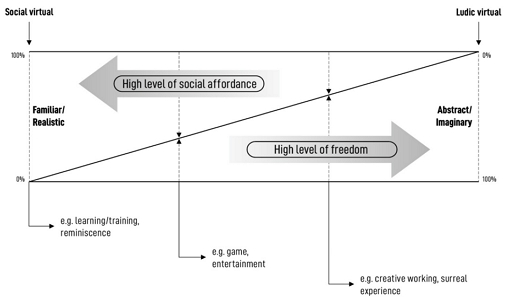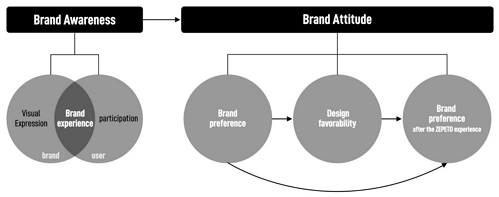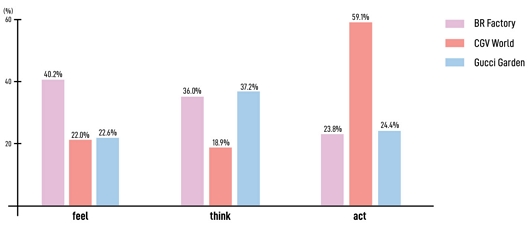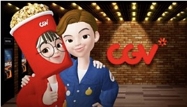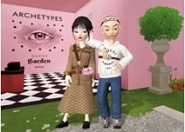
Extending to a New Platform: Characteristics and Effects of Brand Experiences in the Metaverse
Copyright ⓒ 2023 The Digital Contents Society
This is an Open Access article distributed under the terms of the Creative Commons Attribution Non-CommercialLicense(http://creativecommons.org/licenses/by-nc/3.0/) which permits unrestricted non-commercial use, distribution, and reproduction in any medium, provided the original work is properly cited.

Abstract
Brands aim to make brand attitudes through the brand experience. The Metaverse is a novel environment where users can experience brands and become a environment where brands can raise awareness. This research aims to analyze the characteristics of the brand experience that expands to a new platform and how it affects brand awareness and attitude, conducted in research questions on brand experience reflecting the characteristics of the Metaverse. The characteristics of the brand experience were investigated in the representative Metaverse platform, the ZEPETO case. This study showed that a brand represents its core values in new environments, can embrace new technologies, and accepts changes in target consumers' needs. Brands engaging in the Metaverse can initiate a virtuous cycle of network effects, where increased user participation and content reinvestment drive mutual long-term growth.
초록
브랜드는 브랜드 경험을 통해 사용자에게 브랜드를 인지시키고 태도를 형성하고자 한다. 메타버스라는 새로운 플랫폼으로의 확장은 사용자에게 브랜드를 경험할 수 있는 새로운 환경을 제공하며, 브랜드 인지도를 높일 수 있는 공간이 된다. 본 연구에서는 메타버스의 특성을 반영한 브랜드 경험에 대한 연구문제를 통해 새로운 플랫폼으로 확장되는 브랜드 경험의 특성이 브랜드 인지와 태도에 어떠한 영향을 미치는지 분석하고자 한다. 대표적인 메타버스 플랫폼 제페토(ZEPETO) 사례를 통해 브랜드 경험의 특징을 살펴보았다. 메타버스로 확장하는 브랜드들 브랜드 인지를 위한 브랜드 경험이 전제되었고, 사용자는 브랜드의 맥락을 유지하면서 메타버스만의 특화된 표현 방법을 기대하였다. 또한 브랜드는 메타버스로의 확대를 통해 메타버스의 메인 유저인 미래 고객층의 특성을 이해하고 상호적이며 지속적인 커뮤니케이션을 시도하고 사용자 참여와 콘텐츠의 재투자로 이루어지는 선순환적 네트워크 효과가 가능하다는 결과가 추론된다. 아직까지는 메타버스 플랫폼에서 좋은 평가를 받고 있는 브랜드의 시도 조차 사용자를 만족시키기에 부족한 실정이었으나, 새로운 세대를 위한 브랜드 가치 전달과 친밀감 유지를 통한 사용자와의 동반 성장의 가능성은 확인할 수 있었다.
Keywords:
Brand Attitude, Brand Awareness, Brand Experience, Metaverse, New Platform키워드:
브랜드 태도, 브랜드 인지, 브랜드 경험, 메타버스, 뉴 플랫폼I. Introduction
1-1 Background and Research Purposed
The Metaverse is a hot topic in many fields. With the development of information and communication technology following the commercialization of 5G and the increase in online activities due to the COVID-19 pandemic, the Metaverse is extending. The Metaverse, a three-dimensional virtual world where people perform social, economic, and cultural activities like they do in the real world, is becoming a symbol of the changes of the era as much as the Fourth Industrial Revolution[1]. As various physical activities in the real world move to the virtual world, companies and users actively spread work, entertainment, and socializing in the colossal Metaverse platform[2]. Brands have been adapting to this changing environment and distribution trends that cross online and offline to attract users' attention[1]. Design influences consumers' perceptions of branding and consequent market success, so brands seek to represent themselves on new platforms. They also try to reflect the brand experience to establish a new image[3]. These brand activities reflect how the brand experience tailored to the platform's characteristics provides users with specific brand associations or signals, raising their awareness of the brand and opening them to the brand's influence[4].
ZEPETO, a well-known metaverse platform launched by NAVER Z in 2018, allows users to interact using three-dimensional avatars. Since its launch in 2018, 200 million users worldwide have used it[5]. ZEPETO users travel around, take pictures, communicate with friends, and even create mini-dramas in a virtual world through avatars[6]. ZEPETO is developing its metaverse by developing its virtual world in cooperation with various brands to strengthen its content. However, despite the recent interest in virtual worlds, there has been a lack of discussion about the characteristics of brand experiences in them. Thus, it is necessary to understand the characteristics of the Metaverse and look at how users interact with brand experiences. In this study, we analyze the user experience of brands in the Metaverse to determine what factors raise users' brand awareness and how they affect their brand attitudes.
1-2 Research Method
This study was conducted in four parts to determine how the brand experiences in the Metaverse affected users' brand awareness and attitude. In the first part, a literature review was conducted to identify key metaverse characteristics and brand experiences and brand attitudes in it. In the second part, the characteristics of three brands' experiences in ZEPETO were analyzed. In the third part, a survey was given based on a case study and the results were subject to correlation analysis and one-way ANOVA using SPSS 26.0 to identify the brand elements that users recognized and how those elements affected their brand attitude. In the fourth part, a semi-structured in-depth interview and a focus group interview were conducted with ZEPETO users from among the survey subjects to supplement the survey findings. The interviews were subject to thematic analysis to identify the characteristics of the ZEPETO metaverse and the content and visuals for each brand that users experienced. This study used quantitative and qualitative research methods to analyze brand experiences in the Metaverse and how those experiences affect brand awareness and attitude. The implications of its results should be considered by companies designing brand experiences on new platforms.
Ⅱ. Literature Review
2-1 Metaverse Platform
The metaverse is a virtual world where social, economic, and cultural activities occur similar to those that occur in the real world[7]. The COVID-19 pandemic, which began in 2020, caused non-face-to-face contact to become commonplace worldwide, People's for offline activities to decline, and the desire for online communication to increase, all of which led to the rise in popularity of the metaverse, a mix of real and virtual spaces. Brands are also expanding their businesses in metaverses by delivering innovative brand experiences using new digital technologies[8]. In the metaverse, people can experience many things by visiting virtual places without physical restrictions. The main target users of the metaverse are Generation Z individuals born between 1995 and 2010 and Generation Alpha, born between 2010 and 2025 onward and have grown up in a digital age with widespread access to smart devices[9]. To reach new generations of consumers, brands need integrated strategies that combine content experiences and brand values[10].
The Metaverse is composed of ludic and social virtual worlds Table 1. The ludic virtual world more resembles fictional worlds while the social virtual world more resembles the real world. In other words, the Metaverse is composed of ludic elements that do not occur in reality and social elements that reflect people's lived experiences.
The Metaverse reflects people's real-world values and lifestyles. The spatial environment affects human perceptions and the expected characteristics of social places are linked to meaningful experiences through user interactions[11]. In other words, the Metaverse provides users with easy access to activities and should provide them with exciting environments that users will want to stay inn for a long time.
W. Gibson first defined the concept of cyberspace as a "consensual hallucination" in his novel "Neuromancer." Later, when H. Rheingold described the concept as a virtual community that exchanges ideas through a computer network, cyberspace became a core concept in social science. Cyberspace is a network space that enables social interactions through communication and an interface environment that encourages synesthetic immersion[12]. Cyberspace has a dual nature in which it is virtual but is also connected to reality[13]. Cyberspace is designed to make users perceive the illusion of space and allows them to immerse themselves in an environment that feels real but is not. Cyberspace has three components: the scene, self-expression in the form of avatars, and interactions with others through communication and creation tools[12]. These three components are used to build a diverse range of social and ludic virtual worlds in cyberspace.
The more social the world is, the more realistic it is and its experiences correspond closely to real-world experiences Fig. 1. On the other hand, the more ludic virtual the world is, the more imaginary and fantastic it is and its experiences cannot be experienced in the real world, allowing for a much wider variety[12]. Brand design in cyberspace is a strategic plan that attracts consumers' attention and instills a positive brand image in the[14].
The real world is composed of the environment, its layout, human senses, aesthetics, and identity[14]. In the real world, users have multi-sensory experiences, which is different from cyberspace where most experiences are visual[15].
Furthermore, in the real world, users express their emotions physically and based on their physical condition and often remember emotions in connection with a certain place through memories that can last for a long time[16]. They can obtain comprehensive spatial information by exploring their environments[17]. Although when people perceive a space, they do so primarily physically, their sight, hearing, and touch add to the quality of their interactions with the environment[18]. The real world requires us to physically be in it to experience it. Also, it emphasizes direct visual communication and experience by highlighting a relationship orientation of people who value emotion over reason[19].
In the real world, brands combine design elements to form a style and the brand is recognized as a whole through synesthesia[16]. Brands induce consumption by giving people experiences that stimulate their senses. People who visit branded places have sensory experiences, feel emotions, and take actions, all of which give them a sense of awareness of and relationship with a brand[20]. Brands can improve their images by physically connecting with people and giving them experiences[4]. An attractive space is an essential design element. Creating spaces that can accommodate meeting and living can be a successful brand strategy[21].
2-2 Brand Experiences
Visual expression is an essential element of brand design and brands can use visual elements to create new information while maintaining their image[22]. In the era of convergence in which new media, such as smart phones, tablets, and computers, have been developed, media power has become user-oriented due to the increase in the number of synesthetic experiences that transcend time and space and allow for social interaction[7]. These new media are capable of offering a broader range of visual expression and brand experiences and perform better than traditional media[23]. All daily life experiences are related to the space in which they take place and include the area itself, the visual elements of a space can strengthen users' interactions with multi-dimensional sensory experiences[24].
Brand experiences can positively communicate about a brand to people[20]. Brand awareness is recognizing and recalling a brand[25], it is a form of marketing communication about products that builds favor and trust for a certain brand in consumers' minds to influence them when making a purchase[26]. Through brand experiences, users feel the psychological distance of feeling, recognizing, and experiencing[27]. Brand experiences in virtual worlds can create emotional bonds and closing the psychological distance between consumers and brands[15]. Through brand experiences, users gain brand awareness, which has an effect on brand attitudes, leading to preference, immersion, and behavioral signals about the brand[28]. To increase brand awareness, brands should clarify their identity and create links with brand products[26]. Schmitt developed the concept of strategic experience modules (SEM), which contain Sens, Feel, Think, Act, and Relate. Each SEM has its own unique combination of two or more of these elements and creates a valuable user experience according to the brand's purpose[29]. Therefore, brand experience strategies need to be designed according to the brand's characteristics and managed holistically. This study examined brand experiences in the Metaverse in terms of Feel, Think, and Act[30] and how they affected brand attitudes.
2-3 Brand Attitudes
Brands form brand attitudes by harmoniously people's emotions and mental impressions with brand awareness, beliefs, and personalities. Brand attitudes are consumers' overall evaluations of brands[4]. It is critical that brands cause consumers to form brand attitudes because they are related to the brand's attributes, activities, and attachments and become the way that people evaluate the brand and make choices related to it[31]. Positive brand attitudes create value, such as increasing market share, and provide companies with various benefits. Therefore, companies strive to develop positive brand attitudes[10]. Giving consumers positive brand attitudes is essential because they are likely to advertise the brand by word of mouth and buy that brand's products, which affects brand extension[32].
This study measured brand attitude by analyzing brand experience factors on the Metaverse platform and how brand experience affects brand awareness Fig. 2.
Ⅲ. Research
In this study, the way that brands' design characteristics in the metaverse created brand experiences was analyzed. Three world maps within ZEPETO, their characteristics, and brand experiences were analyzed. Next, users were surveyed and in-depth interviews were conducted based on the case study analysis results.
3-1 Case study
The world maps in ZEPETO examined in this study included both social and ludic worlds. The brands present in ZEPETO analyzed in this study were BR Factory, CGV World, and Gucci Garden. BR Factory is a fantasy ice cream factory with ludic virtual world elements. CGV World is a theater with strong social virtual world characteristics. Gucci Garden is mixed social and ludic virtual world that merges a museum in Florence with a Dongdaemun Design Plaza exhibition in Seoul.
Each brand was classified according to its metaverse content[33], virtual space design spectrum[11], and referred to previous studies[34]; the Metaverse platform's design type analysis framework Tables 2~4 were constructed.
The metaverse is a fully immersive virtual 3D environment in which users create value by interacting and collaborating[11]. Cyberspace is an interface environment that creates synesthetic immersion[12]; It measures the virtual space design spectrum of each type of content in the virtual world as the position between cyberspace and the real world for this study based on Fig. 1. Therefore, cyberspace was treated differently from virtual worlds.
In BR Factory, launched by Baskin Robbins, users can experience digital commerce that combines virtual and real spaces in a fairytale-like space in a snowy field. Users can purchase costumes and props for their avatars that reflect the Baskin Robbins brand. Users can pass through an ice cream transformation machine that transforms their avatar into ice cream[35].
The BR Factory is a fantastic ludic virtual world that clearly reflects the brand's name and creates links with related products. The elements that directly show the brand help create brand awareness among users. The world was developed using the brand's products, including various ice cream flavors, and the surreal experience reflects the brand's characteristics well Table 2.
CGV World IS ZEPETO's first movie theater. The manager of CGV said, "We established a new point of contact with customers through the metaverse and provide a differentiated theater experience to customers." Through CGV World, the CGV brand an aim to deliver a variety of unique attractions to users and services that can be enjoyed both online and offline[36].
CGV World is a social virtual world that is designed to resemble a real world movie theater. This similarity was designed to promote brand awareness. Avatars can do things like sit in various seats or take selfies in photo zones; however, it was provided a meaningless action of a just holding a ticket or grabbing popcorn and soda in one's hand but could not eat it. These limitations of the virtual world can lead to less engagement with the brand experience Table 3.
Gucci is one of the luxury brands that have a Metaverse presence. In February 2021, it opened a virtual store called Gucci Villa that appears to be located in Florence, Italy. In Gucci Villa, users can obtain information about new Gucci products and buy Gucci items for their avatars, representing a new source of revenue for Gucci. Later, in March 2022, Gucci opened the immersive multimedia exhibition "Gucci Garden Archetype: Absolute Typical" at the Dongdaemun Design Plaza in Seoul and in ZEPETO at the same time[37]. The exterior of the Gucci Garden resembles Gucci Museo, museum that opened in Florence in a 2011, to reflect how the brand respects nature and its philosophy. Moreover, in connection with the exhibition contents, Gucci Garden is designed to encourage collaboration and creation. It shows Gucci's identity by joining its past with its present[38].
ZEPETO’s Gucci Garden's outside is a real world but its inside is the ludic and social mixed virtual world that resembles the Dongdaemun Design Plaza exhibition. Gucci Garden's exterior is similar to Gucci Mujeo while inside it users can experience the brand's advertisement images and videos. However, it was challenging to find the brand's name and products, users had to move their avatars around the space to find and wear products, but the structure was complex, making it difficult. Thus, the space did not score well in terms of user interaction Table 4.
Brands' top priority was brand visual expressions[25]. Each brand offered different experiences in terms of Feel, Think, and Act. This case study had three major results. The first result was that brands developed their scene using social and ludic virtual worlds according to brand characteristics. In social worlds, avatars could have realistic experiences. In ludic worlds, avatars could have unrealistic experiences. The second result was that brands tried to increase brand awareness through representative design elements specific to each brand, such as colors, interior design elements, and products, as well as the brand's name. BR Factory strongly used the brand's colors, which are the most iconic design element; CGV World designed a real movie theater; and Gucci Garden exhibited the brand's products and advertisements. The third result was that the brands provided experiences for avatars, but they had insufficient interaction effects, which are essential to metaverse places. Most of the activities were conducted on one-sided missions, so they were unlikely to attract users to return.
3-2 Survey
The user's brand awareness and attitude (brand preference, design favorability, and brand preference after the ZEPETO experience) analyzed in the case study in Chapter 3.1 of this study were compared to three brands of ZEPETO. In addition, an online survey was conducted by presenting internal and external brand visual expressions and experiences through avatars as stimuli. When presenting stimuli, direct brand notice was limited by deleting the logo and text of the brand name to control the variables affecting recognition.
The research period of this study was from November 24th to 27th, 29th to December 2nd, 2022, and a survey was conducted by presenting the visual expression and experience of the brand applied to ZEPETO as image stimuli. The demographic characteristics are shown in Table 5.
In addition, correlation analysis and one-way ANOVA were performed using the response values of 164 subjects with SPSS Statistics 26.0, a statistical program to determine the trend of the measured variables. As a result of the reliability analysis, the average Cronbach's Alpha of each item investigating brand awareness and attitude were 0.786, showing high consistency.
Brand awareness survey results were connected to the case study's brand awareness results. The most crucial brand design element for brand awareness was color, which 50.6% of survey respondents said was the most important element in BR Factory with 50.6%. In CGV World, 51.8% of respondents said the interior was the most important element. In Gucci Garden, 51.8% of users said products were the most important element Table 6.
Fig. 3 shows the effects of participating in brand experiences, defined in terms of SEM which contain Feel, Think, and Act, on brand awareness. BR Factory was noted for the fact that it offered evenly distributed experiences. CGV World offered activities that could take place within the theater and promoted brand awareness through Act, more than Feel or Think. Gucci Garden reflected the fact through Think that its products greatly influence brand awareness.
Pearson's correlation analysis was conducted to confirm the correlation between brand awareness and attitude (brand preference, design favorability, and brand preference after the ZEPETO experience), gender, and age, which are significant variables for each brand Table 7~9. Since the correlation analysis is linked to the brand attitude based on the perceived brand, data that did not recognize the brand were deleted from the survey results for the study's accuracy.
As a result, brand awareness of BR Factory showed the most significant positive correlation with design favorability (r=.378, p<.01), and brand preference showed the most significant positive correlation with design favorability (r=.363, p<.01). Furthermore, design favorability showed a significant positive correlation with the brand preference after the ZEPETO experience (r=.617, p<.01) and a significant negative correlation with age (r=-.301, p<.01). This is interpreted as a tendency that the higher the age, the lower design favorability. On the other hand, gender did not show a significant correlation with brand awareness, brand preference, design favorability, and brand preference after the ZEPETO experience Table 7.
Brand awareness of CGV World showed the most significant positive correlation with design favorability (r=.368, p<.01), and brand preference also showed the most significant positive correlation with design favorability (r=.609, p<.01). Design favorability showed a significant positive correlation with the change in brand preference after the ZEPETO experience (r=.560, p<.01) and a significant negative correlation with age (r=-.194, p<.01). This is interpreted as a tendency that the higher the age, the lower the design preference. On the other hand, sex did not show a significant correlation with brand awareness, brand preference, design favorability, and brand preference after the ZEPETO experience Table 8.
The brand awareness of Gucci Garden showed the most significant positive correlation with design favorability (r=.537, p<.01), and brand preference had the most significant positive correlation with the change in brand preference after the ZEPETO experience (r=.455, p<.01). Design favorability had a significant positive correlation with brand preference after the ZEPETO experience (r=.555, p<.01). Gender (r=-.194, p<.01) showed a significant negative correlation. Therefore, it can be seen that women tend to recognize more brands than men. On the other hand, by age, there was no significant correlation between brand awareness, brand preference, design favorability, and brand preference after the ZEPETO experience and sex Table 9.
The survey results showed that the main visual expression elements that most strongly affected brand awareness were slightly different for each brand. BR Factory most strongly utilized color, one of the most important brand identity elements[39], and 80.0% of survey respondents recognized the brand. For CGV World, the strongest element was the interior, and 72.6% of respondents recognized the brand, which was less than BR Factory. Gucci Garden offered products that have a great influence on the symbolic value that is a characteristic of a luxury brand[40], only 58.5% of respondents recognized the brand, which was the lowest of the three brands. These results show that critical brand identity elements directly impact brand awareness.
There were three results related to brand attitude. The first result was that brand awareness was positively correlated with brand preference in the virtual world, design preference, and the change in brand preference after the ZEPETO experience. The second result was that brand preference was positively correlated with design preference and brand preference after the ZEPETO experience. The third result was that brand preference increased after the ZEPETO experience when users liked the brand's designs. However, sex and age were not strongly significantly correlated with brand attitude.
The one-way ANOVA according to whether respondents who recognized the brands had experience with ZEPETO showed no statistically significant difference in brand awareness and attitude, likely due to the fact that the survey was conducted with images because the brand experiences in ZEPETO took place in three-dimensional environments with avatars. Therefore, respondents were interviewed in depth about the characteristics and effects of the brand experiences to better understand the results.
3-3 In-depth Interview
In-depth interviews were conducted to determine whether brand experiences through Avatar in ZEPETO affected users' brand attitudes. Interviewees were ZEPETO users evenly distributed in age from the lower grades of elementary school to users in their 40s. Interviews were conducted during January 3 ~ 12. Interviews were semi-structured in-depth interviews and a focus group interview. The in-depth interviews took an average of 45 minutes and were conducted face-to-face or remotely according to the participant's circumstances. All interviews were recorded and transcripts were made. All participants consented to the interviews. focus group interview allowed participants to freely share their opinions and build off of each other's opinions[41]. Generations Z and Alpha are the main Metaverse targets[9], participants from these generations participated with their parents during the focus group interview.
The interviews were classified using thematic analysis, which can analyze data inductively, so it can summarize, emphasize, and interpret critical features, including participants' experiences and perceptions and social context [42].
The interviews were classified using thematic analysis, which can analyze data inductively, so it can summarize, emphasize, and interpret critical features, including participants' experiences and perceptions and social context [42]. It can also highlight the social, cultural, and structural contexts that influence individual experiences, enable the development of knowledge constructed through interactions between researchers and research participants, and analyze qualitative data that are socially meaningful[43], so it was suitable for use in this study. Ten interviewees were asked five questions about understanding the metaverse platform and 14 questions each about the three brands of ZEPETO, 'BR Factory,' 'CGV World,' and 'Gucci Garden.' The interviewees were delivered a documented questionnaire two days in advance and asked to visit three brands of ZEPETO in advance. During the interview, questions were added according to the story flow of the participants[44]. After collecting responses for each question through interviews, implications for each item were derived, focusing on five keywords; 'Purpose of using the Metaverse,' 'Brand experience,' 'Brand awareness,' 'Brand attitude,' and 'Others.' The main contents of the interview are summarized in Table 11.
Ⅳ. Integrate Results
This study examined how brand experiences in the metaverse affect brand awareness and attitude. We derived implications for brand experiences in the metaverse by quantitative and qualitative analysis. There were four major results.
The first result was that accurate brand awareness is important when brands want to expand to new platforms. As Participant B stated in their in-depth interview, "You have to intuitively perceive the brand to experience a new platform form properly," indicating that brands have to connect to their context to connect with various generations of users, some of whom may have no previous brand experience. This finding was also reflected in the survey results that showed that brand awareness was statistically significantly correlated with brand attitude. The second result was that users expected brand experiences to reflect the metaverse's unique characteristics. The primary reason that brands enter the Metaverse is to increase users' brand attitude and to try to encourage them to try something new. However, more importantly, "When the main target young friends were playing ZEPETO, naturally expose the brand to future consumers" [Participant E] is to plant a brand awareness or attitude in potential customers in the future. In other words, when a brand builds a social or ludic virtual world, it can improve users' brand attitude by satisfying their expectations by introducing exciting elements to them that use metaverse characteristics and that are impossible in reality. The third result is that brands need circular, interactive experiences that connect the real world and cyberspace. Brand preference was statistically significantly correlated with design favorability and brand preference after the ZEPETO experience. Design favorability was positively correlated with brand preference after the ZEPETO experience. The survey results also reflected the respondents' brand attitudes, such as Participant E saying, "What you think about the brand in reality, is unconditionally connected to the virtual world as well." The fourth result was that brands need to engage in continuous interaction and communication with users. Many users mentioned the most effective interaction of the Metaverse is the brand is reflected, only created in a new virtual world's activity. Nevertheless, the dominant opinion was that the current metaverse brand experiences induce unilateral participation, although there were differences between generations and game preferences. Another common opinion was that respondents did not want to return unless they could do different things the next time they came. The results showed that repeat visits were unlikely.
Ⅴ. Discussion and Conclusion
The brand design significantly affects consumer perceptions of brands and consequently their market success[45]. Therefore, this study aimed to explore the considerations for brand design of the metaverse using the characteristics and effects of brand experiences concludes as follows.
This study showed that a brand represents its core values, even in new environments, can embrace new technologies, and accepts changes in target users' needs. Brand design was evaluated holistically[45], so changes in the new platform's brand awareness and attitude seem to have been a result of interaction between the brand and the user. Also, the Metaverse is a new type of environment where users can experience brands and has the potential to become a place where brands can raise awareness of themselves. Brands that want to join the Metaverse should have content and virtual worlds that meet the needs of young generations beyond the concept of creating shared value and must stand out in users' minds by offering easily accessible unconventional experiences. Even though currently brands' virtual worlds received good reviews, they still did not satisfy users. Brands may still be focusing on Creating Shared Value on this new platform, which may differ from users' expectations for the brands. Therefore, brands should understand the psychology and behavioral characteristics of Generation Alpha users because they are the primary metaverse users. They were born and raised with ubiquitous digital technologies and use images and videos as essential means of communication[9]. To secure future customers, brands must strive to deliver value to and maintain connections with Generation Alpha, and the brand must utilize immersive graphics and technologies to build virtual worlds that are compelling for them. Lastly, brands should expect to grow together with users over the long term. The Metaverse presents an expansion opportunity for brands to share experiences with various generations and a space where users can have unique brand experiences that transcend time and space. Brands that try new ways of communication by joining the Metaverse can start a virtuous cycle through the network effect in which user participation and content reinvestment occur.
This study was meaningful in that it identified the characteristics of brand experiences and how they have changed in the metaverse. This study analyzed centrically the scene of each brand's virtual space design spectrum in the metaverse. However, it only examined a limited number of brands and did not examine how brand experiences varied by product category. Future research should examine brand experiences by product category and the integrated utilization of the virtual space design characteristics, including interactions through avatars. Such research can further support brands in producing high-quality brand experiences in the metaverse.
References
-
J.-E. Ee, “Proposal for the Direction of Design Education Based on The Metaverse Environment,” A Journal of Brand Design Association of Korea, Vol. 20, No. 2, pp. 333-342, June 2022.
[https://doi.org/10.18852/bdak.2022.20.2.333]

-
S. Ryu, H. Yun, J. Park, and Y. Chang, “Thesis of the Metaverse Concept and Proposing Research Direction,” Knowledge Management Research, Vol. 23, No. 2, pp. 1-13, June 2022.
[https://doi.org/10.15813/kmr.2022.23.2.001]

-
G. Yu, S. Akhter, T. Kumar, G. G. R. Ortiz, and K. Saddhono, “Innovative Application of New Media in Visual Communication Design and Resistance to Innovation,” Frontiers in Psychology, Vol. 13, 940899, August 2022.
[https://doi.org/10.3389/fpsyg.2022.940899]

-
J. B. Faircloth, L. M. Capella, and B. L. Alford, “The Effect of Brand Attitude and Brand Image on Brand Equity,” Journal of Marketing Theory and Practice, Vol. 9, No. 3, pp. 61-75, 2001.
[https://doi.org/10.1080/10696679.2001.11501897]

- ZDNet Korea. Naver ZEPETO Captivates ‘200 Million People’ with Metaverse [Internet]. Available: https://zdnet.co.kr/view/?no=20210908185709, .
- S. Han, “Metaverse Platform Status and Prospects,” Future Horizon+, Vol. 49, pp. 19-24, June 2021.
-
S. M. Woo and D. R. Chang, “A Study on Metaverse Brand Communication in Trans-media Environment,” A Journal of Brand Design Association of Korea, Vol. 19, No. 2, pp. 29-48, June 2021.
[https://doi.org/10.18852/bdak.2021.19.2.29]

-
J. Luo, “Data-Driven Innovation: What is It?,” IEEE Transactions on Engineering Management, Vol. 70, No. 2, pp. 784-790, February 2023.
[https://doi.org/10.1109/TEM.2022.3145231]

-
R. A. Smith, “Pandemic and Post-Pandemic Digital Pedagogy in Hospitality Education for Generations Z, Alpha, and Beyond,” Journal of Hospitality & Tourism Research, Vol. 45, No. 5, pp. 915-919, June 2021.
[https://doi.org/10.1177/10963480211000818]

-
B. Kim and J. Kim, “The Influence of Branded Content Music Video’s Expression, PPL Layout, and Singer Preference on Brand Recognition and Brand Attitude,” Archives of Design Research, Vol. 34, No. 4, pp. 141-154, November 2021.
[https://doi.org/10.15187/adr.2021.11.34.4.141]

- S. Chung, Comparison of User Behavior and Affective Responses towards Social VR Environments, Ph.D. Dissertation, Yonsei University, Seoul, 2023.
- H. Y. Lim, A Comparative Analysis on the Ego-Identity of University Students in Real and Cyber-Spaces, Master’s Thesis, Yonsei University, Seoul, February 2006.
-
S. Turkle, “Cyberspace and Identity,” Contemporary Sociology, Vol. 28, No. 6, pp. 643-648, November 1999.
[https://doi.org/10.2307/2655534]

-
H. K. Wilson and A. J. Cotgrave, “Learning Space Design: The Presentation of a Framework for the Built Environment Discipline,” International Journal of Construction Education and Research, Vol. 26, No. 2, pp. 132-148, 2020.
[https://doi.org/10.1080/15578771.2020.1727067]

- H. Kim, A Study on Spatiality for Brand Identity Design in Digital Virtual Space, Master’s Thesis, Yonsei University, Seoul, August 2016.
-
J.-Y. Kim and H.-C. Lyu, “A Study on the Embodiment Characteristics of Space Branding for Brand Extension,” Journal of the Korean Institute of Interior Design, Vol. 22, No. 5, pp. 96-105, October 2013.
[https://doi.org/10.14774/JKIID.2013.22.5.096]

- M. L. Hidayetoglu, K. Yildirim, and K. Cagatay, “The Effects of Training and Spatial Experience on the Perception of the Interior of Buildings with a High Level of Complexity,” Scientific Research and Essays, Vol. 5, No. 5, pp. 428-439, March 2010.
- M. Merleau-Ponty, Eye and Mind, in Theatre and Performance Design, Abingdon, UK: Routledge, ch. 32, pp. 243-245, 2012.
-
J. B. Barhorst, G. McLean, E. Shah, and R. Mack, “Blending the Real World and the Virtual World: Exploring the Role of Flow in Augmented Reality Experiences,” Journal of Business Research, Vol. 122, pp. 423-436, January 2021.
[https://doi.org/10.1016/j.jbusres.2020.08.041]

-
J. J. Brakus, B. H. Schmitt, and L. Zarantonello, “Brand Experience: What is It? How is It Measured? Does It Affect Loyalty?,” Journal of Marketing, Vol. 73, No. 3, pp. 52-68, May 2009.
[https://doi.org/10.1509/jmkg.73.3.052]

- S. Hong, Space Marketing, Seoul: Samsung Economic Research Institute, 2007.
-
G. M. Mejía and S. Chu, “A Model for Visual Communication Design: Connecting Theories of Rhetoric, Literacy and Design,” The Design Journal, Vol. 17, No. 1, pp. 29-43, 2014.
[https://doi.org/10.2752/175630614X13787503069918]

- J.-W. Won, “A Study on the BX Design for the Improvement of Brand Value in the Metaverse Environment,” Journal of Communication Design, No. 81, pp. 8-20, October 2022.
-
G. Lakoff and M. Johnson, “Conceptual Metaphor in Everyday Language,” The Journal of Philosophy, Vol. 77, No. 8, pp. 453-486, August 1980.
[https://doi.org/10.2307/2025464]

-
K. L. Keller, “Conceptualizing, Measuring, and Managing Customer-Based Brand Equity,” Journal of Marketing, Vol. 57, No. 1, pp. 1-22, January 1993.
[https://doi.org/10.1177/002224299305700101]

- D. Aaker, Managing Brand Equity, Seoul: UX Review, 2021.
-
Y. Trope and N. Liberman, “Temporal Construal,” Psychological Review, Vol. 110, No. 3, pp. 403-421, 2003.
[https://doi.org/10.1037/0033-295X.110.3.403]

-
B. Yoo, N. Donthu, and S. Lee, “An Examination of Selected Marketing Mix Elements and Brand Equity,” Journal of the Academy of Marketing Science, Vol. 28, No. 2, pp. 195-211, March 2000.
[https://doi.org/10.1177/0092070300282002]

-
B. Schmitt, “Experiential Marketing,” Journal of Marketing Management, Vol. 15, No. 1-3, pp. 53-67, 1999.
[https://doi.org/10.1362/026725799784870496]

-
J.-S. Cho, S.-M. Lee, and D.-H. Kim, “The Influence of Consumer Experience on Brand Website on Brand Behavioral Intention: Focusing on the Theory of Online Strategic Experience Modules (SEMs),” Journal of Franchising, Vol. 8, No. 2, pp. 75-99, July 2022.
[https://doi.org/10.22985/kasof.2022.8.2.004]

-
K. L. Keller, “Brand Synthesis: The Multidimensionality of Brand Knowledge,” Journal of Consumer Research, Vol. 29, No. 4, pp. 595-600, March 2003.
[https://doi.org/10.1086/346254]

-
S. M. Broniarczyk and J. W. Alba, “The Importance of the Brand in Brand Extension,” Journal of Marketing Research, Vol. 31, No. 2, pp. 214-228, May 1994.
[https://doi.org/10.1177/002224379403100206]

- H. W. Han, “A Study on Typology of Virtual World and Its Development in Metaverse,” Journal of Digital Contents Society, Vol. 9, No. 2, pp. 317-323, June 2008.
-
H. Lee and J. Han, “A Study on Classification and Characteristics of Metaverse Platforms According to Experience Types - Focus on Representative Cases of Realistic and Hyper-Realistic Metaverse -,” Journal of the Korea Institute of the Spatial Design, Vol. 16, No. 8, pp. 427-435, December 2021.
[https://doi.org/10.35216/kisd.2021.16.8.427]

- SPC Magazine. Meet Baskin Robbins in the Metaverse [Internet]. Available: https://www.spcmagazine.com/, .
- Sports Chosun. ZEPETO’s First Cinema CGV World Opened on the 28th [Internet]. Available: https://www.chosun.com/entertainments/entertain_photo/2022/01/28/DCTJYRKYVN2RPSROO7MG5K4TNM/, .
- Edaliy. ‘Gucci Garden Archetype Seoul’ in ZEPETO [Internet]. Available: https://www.edaily.co.kr/news/read?newsId=01722006632261024&mediaCodeNo=257&OutLnkChk=Y, .
- Korea Textile News. Gucci Opens ‘Gucci Garden’ in Florence, Italy [Internet]. Available: http://www.ktnews.com/news/articleView.html?idxno=105785, .
- A. Wheeler, Designing Brand Identity: An Essential Guide for the Whole Branding Team, 5th ed. Hoboken, NJ: John Wiley & Sons, 2018.
-
T. M. Lee, “A Comparative Study on the Dual Path of Luxury-Non-Luxury Brand Loyalty: Investigating the Relative Impact of Cognitive and Affective Path,” Journal of Commodity Science and Technology, Vol. 28, No. 4, pp. 61-77, July 2010.
[https://doi.org/10.36345/kacst.2010.28.4.006]

- D. L. Morgan and R. A. Krueger, When to Use Focus Groups and Why, in Successful Focus Groups: Advancing the State of the Art, Newbury Park, CA: Sage, ch. 1, pp. 3-19, 1993.
-
M. E. Kiger and L. Varpio, “Thematic Analysis of Qualitative Data: AMEE Guide No. 131,” Medical Teacher, Vol. 42, No. 8, pp. 846-854, 2020.
[https://doi.org/10.1080/0142159X.2020.1755030]

-
V. Braun and V. Clarke, “Using Thematic Analysis in Psychology,” Qualitative Research in Psychology, Vol. 3, No. 2, pp. 77-101, 2006.
[https://doi.org/10.1191/1478088706qp063oa]

- J. W. Creswell and J. C. Báez, 30 Essential Skills for the Qualitative Researcher, 2nd ed. Thousand Oaks, CA: Sage, 2020.
- SSRN(Social Science Research Network). Design and Evaluation of Product Aesthetics: A Human-Machine Hybrid Approach [Internet]. Available: https://ssrn.com/abstract=3421771, .
저자소개

1998년:이화여자대학교 (미술학사)
2009년:Parsons the New School of Design, Certification of Fashion Design
1998년~1999년: VMD & PR of ETRO, Duo Trading Co. Ltd.
2001년~2004년: Designer, SG세계물산(주)
2004년~2008년: in-charge Designer, Duty Free Division, (주)호텔신라
2008년~2013년: Director of Shinsegae Dept. VM Design, DKDC Corp.
2014년~2020년: VMD Team Deputy General Manager, SPC Group & BR KOREA LTD.
2020년~현 재: 우송대학교 테크노미디어융합학부, 강사
2020년~현 재: 연세대학교 생활디자인학과 석박사통합과정
2023년~현 재: 을지대학교 의료홍보디자인학과, 강사
※관심분야:브랜드 디자인(Brand Design), 브랜드 경험(Brand Experience), 시각 커뮤니케이션(Visual Communication), 플랫폼 확장(Platform Expansion) 등

1986년:TAMA ARTS University, Japan (시각디자인 석사)
1990년:Tokyo University of the Arts, Japan (디자인 박사)
1990년~1992년: Design Focus Inc. 아트디렉터
1993년~1997년: 대전전문대학 조교수
2001년: 연세대학교 대외협력처 디자인팀장
2003년: 연세대학교 디자인기획팀 팀장
2005년: 연세대학교 연세디자인센터 소장
1997년~현 재: 연세대학교 생활과학대학 생활과학부 생활디자인전공 교수
※관심분야:브랜드 디자인(Brand Design), 시각 커뮤니케이션(Visual Communication), 사회혁신(Social Innovation) 등

